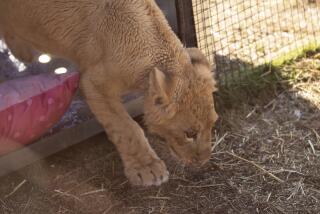The tragic death of one silly giraffe, Marius, has world in uproar
- Share via
On Sunday, zookeepers at the Copenhagen Zoo in Denmark put a bolt through the brain of a healthy, 18-month-year old male giraffe nicknamed Marius, and invited the public to watch them skin and dismember him, then feed him to the lions.
The world, in response, has gone slightly crazy.
But why should anyone care about one silly, surplus giraffe when a generation of children in Syria, for instance, is being brutalized and starved?
Ah, well, you already know the answer to that one: It’s so much easier to focus on the fate of one helpless animal than to wrap our heads around all the real outrages that are taking place. That’s just human nature.
And if the thought of killing a zoo giraffe and feeding it to the lions fills you with revulsion, as it does me, that’s because it’s revolting.
“It is not possible to transfer the giraffe to another zoo as it will cause inbreeding,” the zoo said in a statement on its website, noting that giraffes may not have contraceptives as they have “a number of unwanted side effects on the internal organs.” (As opposed to, um, death?)
All the scientific blather in the world is not going to turn such a cold-blooded act into something heroic or beautiful.
Copenhagen Zoo officials have taken pains to explain their scientific rationale, but the larger question this story raises has to do with the devil’s bargain we strike in order to have zoos.
On one hand, they educate people, inspire them and help ensure the survival of endangered species. On the other, they confine and stress animals meant to roam. Also, everyone loves a baby animal, but then overbreeding becomes a problem. Here is a good list of the pros and cons for zoos.
Many animal lovers have vowed to stay away from marine parks after watching “Blackfish,” the HBO documentary that presents a scathing depiction of how SeaWorld has captured and treated its orcas, or killer whales.
And, of course, almost no credible animal expert believes these days that elephants should be kept in traditional captivity or used as circus animals.
So what, exactly was Marius’ crime?
Turns out, he was a genetic bore. His DNA was already well represented by the zoo’s other giraffes, and transferring him elsewhere would violate the rules of the European Assn. of Zoos and Aquaria.
In a Q & A about Marius on its website, the zoo explained that the rules of the association forbid it from selling Marius, who apparently existed to ensure that European zoos have a supply of healthy giraffes:
“Copenhagen Zoo’s giraffes are part of an international breeding programme which aims at ensuring a healthy giraffe population in European zoos,” the zoo said. “This is done by constantly ensuring that only unrelated giraffes breed so that inbreeding is avoided. If an animal’s genes are well represented in a population, further breeding with that particular animal is unwanted.”
The killing, naturally, sparked outrage.
Thousands of people had signed a petition asking the zoo to spare the animal’s life. Copenhagen zookeepers even spurned a last-minute offer for him from a zoo in Britain where Marius’ brother lives, according to the Associated Press.
“I know the giraffe is a nice looking animal, but I don’t think there would have been such an outrage if it had been an antelope, and I don’t think anyone would have lifted an eyebrow if it was a pig,” Bengt Holst, the zoo’s scientific director, told the AP.
But with all due respect, no one goes to a zoo to see a pig or an antelope.
They go to be enchanted by the giraffes, to gaze upon their otherworldly necks, their starlet lashes, their bold and beautiful coats.
They do not go to see them reduced to lion food.
ALSO:
Twitter: @robinabcarian
More to Read
Sign up for Essential California
The most important California stories and recommendations in your inbox every morning.
You may occasionally receive promotional content from the Los Angeles Times.














